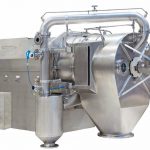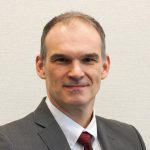Various risks arise in manufacturing processes such as filtering, sieving, agitating and separating from the type of substances and media used, for example solvents or flammable hazardous materials. Handling and processing can also be dangerous, as can the processes themselves. Since these risk factors often vary considerably in practice, a specific solution has to be developed and implemented for risk avoidance. The Heinkel Drying and Separation Group supports users with many years of practical know-how backed up by a specially developed, TÜV-tested inerting system. Heinkel Centripurge is suitable for all machine models in the Heinkel Group’s portfolio as well as for third-party makes. The inerting system has a modular design which enables individually tailored safety solutions based on advanced technologies and conforming to current guidelines and regulations.
Individual explosion safety
When a specific inerting solution is developed, the approach is always the same. The first step is to take stock of the situation and carry out an overall assessment using the hazop (hazard and operability) method which is commonly applied for risk management. The customer’s explosion protection documentation is decisive for the risk assessment. The process components to be inerted, such as centrifuges or dryers, are then analysed comprehensively with regard to the actual processes. Potential hazards – not only of individual components but also of the whole system – are revealed in this way. Thus, even though each individual component is considered safe, the system as a whole could nevertheless show safety deficits. Each system is ultimately only as secure as its weakest part. If this part is not inerted because there was no explosion risk initially, the explosion zone could be “carried over”, with impacts on the entire system.
Plant safety concept
In the second step, Heinkel specialists develop a safety concept for the overall system. Heinkel Centripurge, the Heinkel inerting system, is used as technical apparatus; due to its modular design, control components and the associated peripheral systems are easy to replace. The motto: as simple as possible and as much as necessary. SIL 3, the highest safety integrity level, can also be achieved with Heinkel Centripurge if required. The inerting system has been tested and approved by TÜV Süd and is in conformity with TRGS 725. The concept is ideal whenever pharmaceutical and chemical applications demand the highest levels of quality and safety, for example the manufacture of active pharmaceutical ingredients, agrochemicals or dietary supplements. As a standardised system, it minimises the effort for validation because the complete documentation is already approved. In addition, the modular design enables individual inerting systems tailored to actual needs, which can be upgraded at any time without difficulty.
Safe inerting in three phases
The SIL level is determined by analysing the failure behaviour of the components concerned and checking them for redundancies, continuity and errors. The Heinkel inerting concept is based on the principle of flow-through inerting. As soon as the process component is switched on, the nitrogen inerting system is activated. During the first, diagnostic phase, the leak-tightness of the process housing as well as of the connecting pipework between the inerting cabinet and the process component is tested by charging with a predefined inert gas flow, where a set increase in pressure has to be achieved. This test is time-controlled and safely monitored by means of a pressure transmitter. If it is successful, the second, rinsing phase introduces a large amount of nitrogen into the process housing. During this initial inerting, the oxygen content is reduced below the process-specific requirement. The rinsing phase is likewise time-controlled and monitored by a flowmeter. In the final phase, a continuous supply of inert gas compensates plant-specific or operational leakage flows and pressure variations. Single or redundant monitoring of the pressure housing is possible depending on the SIL level. All instruments needed for the autonomous inerting unit are installed in a stainless steel cabinet close to the process component.
Online search: cpp0119heinkel
Hall 4A, Booth 128










